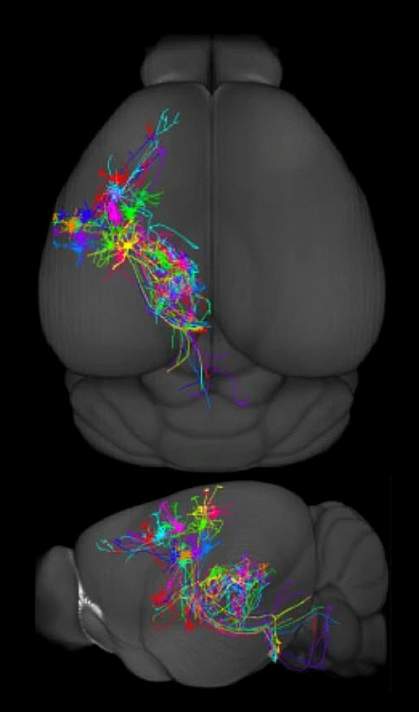You are here
October 26, 2021
Mapping the mammalian motor cortex
At a Glance
- Researchers unveiled an atlas of cell types for the mammalian primary motor cortex and a wiring diagram of the region.
- Derived from studies of mice, monkeys, and humans, the atlas provides a roadmap for understanding the mammalian brain.

The human brain is an incredibly complex organ. It’s made up of about 90-100 billion nerve cells, or neurons, along with roughly the same number of other cells. There are trillions of neuronal connections in the brain, and each person’s brain is unique. How your brain develops and functions depend on many factors, including your genetics and the environments you grew up in. Understanding the differences in people’s brains may help scientists better understand mental health and diseases, such as schizophrenia, addiction, seizure disorders, and Alzheimer’s disease.
To develop a comprehensive reference catalogue of all the cell types in the brain, NIH’s BRAIN Initiative Cell Census Network (BICCN) brought together more than 250 scientists at more than 45 institutions across three continents for a coordinated mapping effort. The group started by mapping the locations, molecular profiles, and functions of all of the cells in one brain region: the motor cortex. The motor cortex is responsible for directing complex body movements and is known to have a similar role across mammalian species. The researchers compared the cells in this brain region across three species: humans, monkeys, and mice. Their results were published in a series of 17 papers in the journal Nature on October 6, 2021.
In the flagship paper, the researchers gave an overview of the reference atlas. Based on experiments with millions of cells, they described a cross-species, data-driven framework of brain cell types in the motor cortex. They characterized the cell types and traced neural circuits using a variety of diverse approaches.
The effort revealed that motor cortex cells could be organized in a hierarchy of families and classes. At the highest level, the researchers identified 25 general cell types—16 neuronal and nine non-neuronal—that were distinct and conserved across the three species. But the team also found important differences in gene expression between species that may account for variation in the way these three species process neural information. The cell types in the human brain, for example, showed more diversity.
The group also created a wiring diagram of the motor cortex by tracing where the defined cell types project to and from in the brain. Most of the cells formed a complicated network, with multiple connections in different brain areas.
In addition, the team developed genetic tools to precisely monitor and modulate the neural activity of specific cell types. These tools will be useful for future studies to parse out the roles of the different cell types.
“This work represents a crucial step that will dramatically enhance the pace of advances in understanding the brain,” says Dr. Joshua Gordon, director of NIH’s National Institute of Mental Health (NIMH).
“Thanks to this groundbreaking collaboration, we now have a comprehensive understanding of the brain cells found in the motor cortex of the brain and their basic functional properties,” says NIH Director Dr. Francis S. Collins. “The atlas will provide a springboard for future research into the structure and function of the brain within and across species.”
Related Links
- Building an Atlas of Brain Function in Mice
- Mental Disorders May Share Molecular Origins
- An Expanded Map of the Human Brain
- Landscape of Gene Expression in the Human Body
- An Atlas of the Developing Human Brain
- Complex Brain Has Simple Grid Structure
- Genes and the Brain
- Technology Gives Scientists Peek Deep Into Brain
- BRAIN Initiative Cell Census Network (BICCN)
References: A multimodal cell census and atlas of the mammalian primary motor cortex. BRAIN Initiative Cell Census Network (BICCN). Nature. 2021 Oct; 598(7879):86-102. doi: 10.1038/s41586-021-03950-0. Epub 2021. Oct 6. PMID: 34616075.
Brain Initiative Cell Census Network Collection. Nature. 2021 Oct 6.
Funding: NIH’s National Institute of Mental Health (NIMH), National Institute of Neurological Disorders and Stroke (NINDS), Office of Research Infrastructure Programs (ORIP), National Center for Advancing Translational Sciences (NCATS), National Eye Institute (NEI), and Office of the Director (OD); Chan Zuckerberg Biohub (CZ Biohub); Deutsche Forschungsgemeinschaft (German Research Foundation); German Federal Ministry of Education and Research; Salk Institute; Hearing Health Foundation; National Natural Science Foundation of China (NNSFC); University Synergy Innovation Program of Anhui Province; Howard Hughes Medical Institute; Klarman Cell Observatory; NSF Shanghai; Allen Institute for Brain Science.
